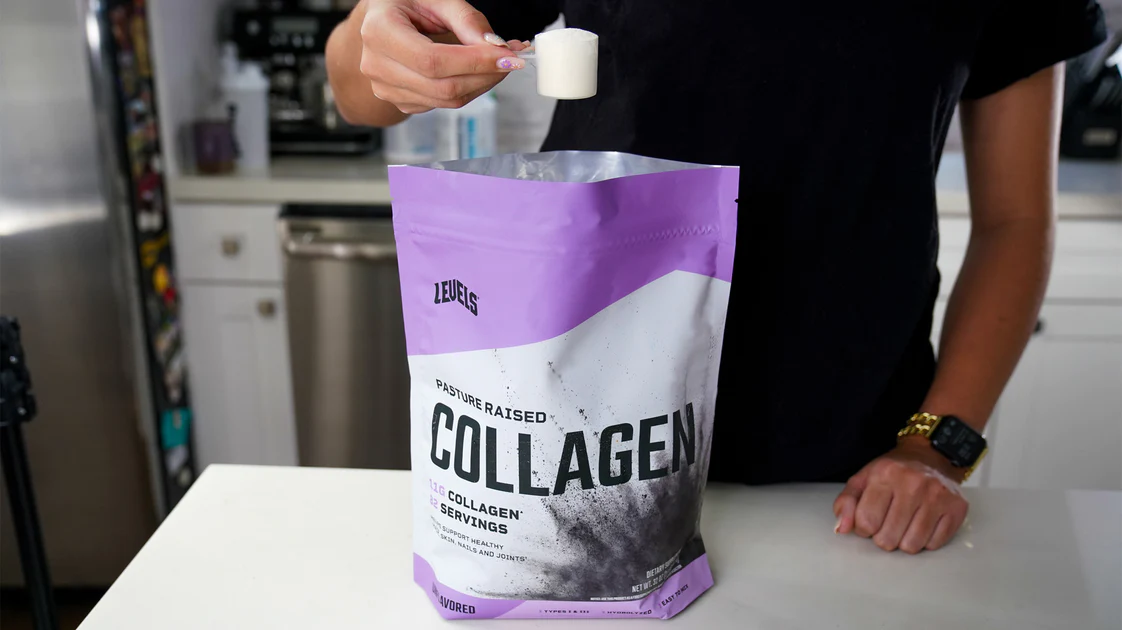Collagen is the most abundant protein in the human body, serving as the main structural protein of skin, tendons, ligaments, and bones.
Although milk-based protein, specifically whey, dominates the global protein market, in part because it is inexpensive to manufacture compared with other protein sources and offers high bioavailability, collagen supplements are increasing in popularity.
This article provides an overview on the benefits, types, and market of collagen.

Collagen is a structural protein composed primarily of glycine, proline, and hydroxyproline. The primary amino acid sequence of collagen is glycine-proline-X or glycine-X-hydroxyproline. X represents any of the other 17 amino acids.
The structures collagen form determines its type. There are 28 types of collagen, but by far, the most common are types I through V, with type 1 comprising over 90% of the collagen in the human body. Here’s a look at the five most common types of collagen, their application, and the tissue or organ in which they are present.
| Collagen | Function or Application | Tissue or Organ |
| Type I | Cell-bone matrix, bone regeneration | Skin, bone, teeth, tendons, ligament, vascular ligature |
| Type II | Cartilage repair, arthritis treatment | Cartilage |
| Type lll | Reticular fibers (supporting mesh of soft tissues) | Muscle, blood vessels |
| Type IV | Basal lamina component, cell attachment surface treatment, marker of nephropathy | Basal lamina |
| Type V | Corneal regeneration treatment | Hair, cell surfaces, placenta |
Table 1 adapted from Wang H1

Collagen can be extracted from natural animal and plant sources or be obtained from protein production systems using bacteria, yeast, insects, mammalian cells, or artificial fibrils.1 The most common animal collagen sources include bovine (cow), porcine (pig), and marine organisms.
A hydrolysis extraction process can be used, depending on the origin of the raw materials. Hydrolyzed collagen (collagen peptides) has a higher solubility in water compared with native collagen and is generally more bioavailable.
Collagen types I, II, and III are most commonly used for dietary supplements and cosmetics. Type I is mainly derived from marine collagen, type ll from chicken and bovine collagen, and type lll from porcine and bovine collagen.
These supplements may offer therapeutic benefits for1:
Other promising research suggests collagen treatments like injections and medical and dental scaffolds may be useful for managing bone defects, gastroesophageal reflux (GERD), and periodontal disease.

According to a 2021 analysis by Grand View Research, the global collagen market is expected to grow at a compounded annual growth rate of 5.5% over the next seven years to reach $2.88 billion by 2028. Driving this growth is an increase in consumers’ knowledge and awareness surrounding collagen’s benefits, especially as they relate to healthy aging.
Pills and gummies accounted for more than half of the global market revenue in 2021; however, collagen powder is expected to experience the highest growth through 2028 according to the analysis.
Bovine-derived collagen is likely to exhibit major growth, owing to its therapeutic role for joint and skin health. Though, depending on the source from which its derived, some people may have sensitivities or allergies to collagen supplements.
An increased adoption of vegetarian diets are expected to limit market growth. As an alternative, some brands offer products known as collagen builders or boosters.
Collagen builders don’t contain collagen but contain building blocks for collagen production such as biotin and vitamin C, other cartilage forming-molecules like hyaluronic acid, and plant-based ingredients rich in the amino acids necessary for its synthesis.
Collagen is the body’s most abundant protein and provides structure to hair, skin, nails, ligaments, tendons, and bones. Of the 28 types of collagen, types I through V are the most abundant in the body, with type I comprising 90% of the body’s collagen.
Collagen supplements originate from various sources, including porcine, bovine, and marine, and may offer therapeutic benefits for various conditions and health goals.
The global market for collagen supplements is expected to stay strong in the coming years, driven by consumers seeking targeted health solutions, especially in relation to healthy aging.
References
The views, opinions and technical analyses presented here are those of the author or advertiser, and are not necessarily those of ULProspector.com or UL. The appearance of this content in the UL Prospector Knowledge Center does not constitute an endorsement by UL or its affiliates.
All content is subject to copyright and may not be reproduced without prior authorization from UL or the content author.
The content has been made available for informational and educational purposes only. While the editors of this site may verify the accuracy of its content from time to time, we assume no responsibility for errors made by the author, editorial staff or any other contributor.
UL does not make any representations or warranties with respect to the accuracy, applicability, fitness or completeness of the content. UL does not warrant the performance, effectiveness or applicability of sites listed or linked to in any content.